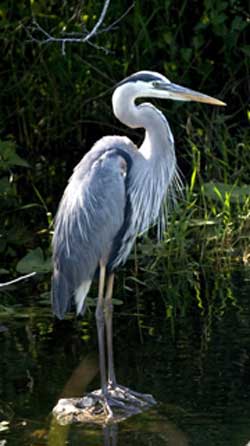
Photo Courtesy The International
Sea Keepers Society
sawgrass (Claudium jamaicenese), interspersed with a mosaic of islands and sloughs (liner swamps), flowing gently to Florida Bay. Far too many people, however, locked onto the image of a river of grass and lost sight of the extreme habit diversity of the system.
In reality, the Everglades is a series of interconnected ecosystems variously linked hydrologically over temporal scales from seasonal to decadal, punctuated by occasional catastrophic climatic events, including extended drought and hurricanes.
The Everglades is the most extensively studied large wetland system in the world. A literature search in May 2006 identified 1,299 refereed papers for the Everglades, followed by 367 for Donana in Spain and 335 for the Pantanal of Brazil, the largest wetland in the world (Web Science 2006).

National Park Service Photo by Rodney Cammauf
The Great Blue Heron resides in the Everglades in South Florida as one of the largest wading birds.
As a result of the natural system’s deterioration, water shortages are not uncommon for South Florida’s communities.
In the past, the limestone rock beneath the soil absorbed rainwater like a sponge, replenishing the natural aquifer. But human-made changes now divert the flow of freshwater before it soaks into the ground. Miles of paving, brought on by development of the human habitat, also prevent rainwater from penetrating the soil and entering the aquifer.
Restoration efforts require more effective diversions and conservation of water to make it available to the ecosystem and for local water supplies.
Quantity is not the only issue: water quality is also of great concern. If less freshwater enters the aquifer, the probability of saltwater intrusion is increased, and agricultural runoff, including varying levels of pesticides, herbicides, fungicides, nitrogen, and phosphorous, contribute to the degradation of the water’s purity.
The fate of South Florida’s water supply is directly related to the quantity and quality of water in the natural Everglades. Thus the long-term survival of all species in the region depends upon successful Everglades restoration.
From the book, Large-Scale Ecosystem Restoration, edited by Mary Doyle and Cynthia A. Drew, University of Miami faculty
Synopsis
Large-Scale Ecosystem Restoration: Five Case Studies from the United States
Large-Scale Ecosystem Restoration presents case studies of five of the most noteworthy large-scale restoration projects in the United States: Chesapeake Bay, the Everglades, California Bay Delta, the Platte River Basin, and the Upper Mississippi River System. These projects embody current efforts to address ecosystem restoration in an integrative and dynamic manner, at large spatial scale, involving whole (or even multiple) watersheds, and with complex stakeholder and public roles. Representing a variety of geographic regions and project structures, the cases shed light on the central controversies that have marked each project, outlining:
- the history of the project
- the environmental challenges that generated it
- the difficulties of approaching the project on an ecosystem-wide basis
- techniques for conflict resolution and consensus building
- the ongoing role of science in decision making
- the means of dealing with uncertainties
A concluding chapter offers a guide to assessing the progress of largescale restoration projects. Large-Scale Ecosystem Restoration examines some of the most diffi cult and important issues involved in restoring and protecting natural systems. It is a landmark publication for scientists, policymakers, and anyone working to protect or restore landscapes or watersheds.
News Release
UM Law Professors Publish a Book on Large-Scale Ecosystem Restoration

Mary Doyle

Cynthia Drew
University of Miami School of Law professor Mary Doyle, and associate professor Cynthia A. Drew, have just published Large Scale Ecosystem Restoration: Five Case Studies from the United States. In addition to serving as co-editors of the book, they authored and contributed to several chapters. The book is cosponsored by the Society for Ecological Restoration International and Island Press, and is part of a series of books on the science and practice of ecological restoration.
The book examines difficult and important issues involved in restoring and protecting natural systems, and presents case studies of five of the most noteworthy large-scale restoration projects in the United States: Chesapeake Bay, the Everglades, the California Bay Delta, the Platte River Basin, and the Upper Mississippi River System.
Each case study details the history of the project, the environmental issues that generated it, the challenges of large-scale projects, techniques for resolving conflicts and building consensus, the ongoing role of science in decision making, and the means of dealing with uncertainties. An additional concluding chapter offers a guide to assessing the progress of large-scale restoration projects.
Professor Doyle served as dean of the University of Miami School of Law from 1986 to 1994 and as interim dean from 1998 to 1999. From fall 1999 through 2001, she served during the Clinton administration as acting Assistant Secretary of the Interior for Water and Science, and chaired an intergovernmental panel coordinating a massive 20-year $7.3 billion Everglades restoration program. She has also served as associate general counsel of the Environmental Protection Agency. Professor Doyle spearheaded the creation of the University’s Leonard and Jayne Abess Center for Ecosystem Science and Policy, and serves as its co-director. She teaches property, water law, and land use.
Professor Drew served as program manager of the South Florida Water Management District’s first Surface Water Improvement and Management Plan for the Indian River Lagoon (now an estuary of national significance). She also practiced environmental law at both Jenner & Block in Chicago, and the Environment & Natural Resources Division, U.S. Department of Justice in Washington, D.C., where she represented the United States in both U.S. district and appellate courts. She teaches natural resources and energy law as well as administrative law, was recently published on the Everglades and Endangered Species Act regulations, and is a Florida certified mediator.
Both Professor Doyle and Professor Drew have researched and written extensively on the Florida Everglades.
Island Press Catalog Page for “Large-Scale Ecosystem Restoration”
Leonard and Jayne Abess Center for Ecosystem Science and Policy

